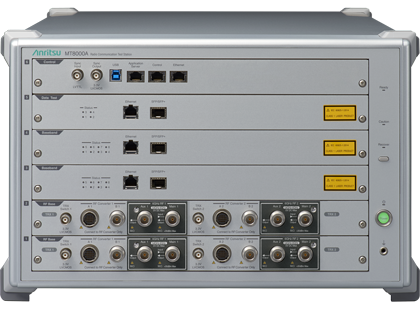Anritsu Introduces Advanced 5G Device Test Solution to Accelerate High-speed, High-capacity Communications
Anritsu introduces two software options for its Radio Communication Test Station MT8000A, designed to evaluate the RF performance of 5G devices. The software options support key technologies specified in 3GPP Release 17, including 1024QAM modulation for downlink and Tx Switching 2Tx to 2Tx for uplink, enabling accurate and flexible evaluation of 5G devices with enhanced transmit/receive (TRx) performance.
The NR DL 1024QAM MX800010A-022 software enables RF testing for downlink 1024QAM modulation and delivers approximately 25% improved receiver performance compared to the current 256QAM standard for the same frequency bandwidth. The NR UL Tx Switching 2Tx to 2Tx MX800010A-019 software supports RF testing for uplink transmission switching technology. It dynamically switches between multiple antennas based on communication conditions to ensure stable and high-speed transmission performance. It improves uplink stability and speed by providing.
Anritsu has developed two software options to address new technologies being implemented since 5G commercialization, such as AR/VR, 8K video, and live streaming, as they require a test environment that can accurately and flexibly evaluate the transmission and reception performance of 5G devices. These technologies are expected to be adopted in the FR1 frequency bands for use in a wide range of use cases – from entertainment like ultra-high-definition video streaming and cloud gaming to business use cases such as teleworking and cloud services.
MT8000A Platform
The new software further positions the Radio Communication Test Station MT8000A as a comprehensive single solution to verify the performance of 5G devices. It provides all-in-one support for RF measurements, protocol tests, and applications tests in FR1 and Frequency Range 2 (FR2) (millimeter-wave) bands.
Combining the Test Station with an Over-the-Air (OTA) chamber enables millimeter-wave band RF measurements and beamforming tests using call connections specified by 3GPP. An intuitive, state-machine-based GUI supports various application measurements, including handover tests, and quasi-normal and abnormal network tests. Additionally, maximum IP data throughput can be measured for a wide variety of bands, CA, and MIMO combinations.

